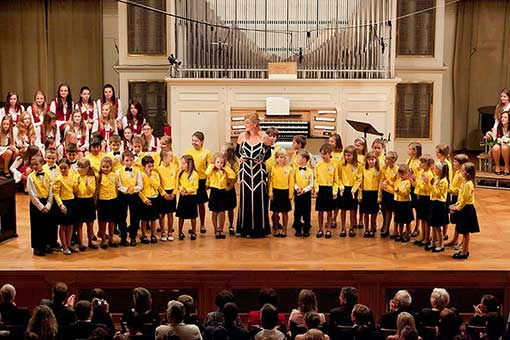Of all the Christian holidays, Christmas is the musically richest and it is usually hard on musicians. They are, however, not angry about it ; besides a certain extra income, Christmas music brings them an indefinable feeling of Christmas which takes them back to their childhood and can be experienced just once a year. Even the Bolshevik failed to eradicate this, no matter how hard he tried. Once, when there were comments from the region that members of the philharmonic organisation attend Christian churches during the holiday and serve black clericalism, the philharmonic officers voted (with calendars already full of Christmas ceremonies) that they will not even step inside a church this time – and then they watched, clenching their teeth, how their warm seats in the choir stalls were occupied by their colleagues from the opera where they did not take servility so seriously.
However, thanks to these restrictions, the tradition of Christmas concerts bloomed in an unprecedented way and there was not an ensemble that would not invite its listeners on the journey to the nativity scene. The Moravian Quartet, however, joined initially but somehow they did not have the means how: you will not find a proper Christmas composition in the classical quartet repertoire – and so they helped themselves with the pearls from their educational programmes. Therefore, the violoncellist Bedřich Havlík, who is the best among us at writing music, took over the matter; and because his obligations at JAMU did not give him enough time for responsible creation in Brno, he began to carol on tours. He processed Silent Night in the middle of a rough sea while sitting on a suitcase on board an ancient Belgian ferry from Ostend to Dover significantly covered in throw-up; on Ischia he then – during an extremely hot summer – refused to go swimming in the afternoon before the concert (the beach was a few steps away from the hotel) because he was just finishing the second variant of Ejhle, chasa naša; he got to experience true Christmas scenery by the snowy wooden town of Askersund in the woods on the northern shore of Lake Vättern in Sweden but it was a little too late for Nesem vám noviny at that point – in mid-January.
Bedřa's carol suite was of great benefit for the Christmas concert of the Moravian Quartet; however, they were still missing something: the human voice. And more of us got into the creative work – and in the coming years, ladies from Janáček's opera began to rotate at our Christmas concerts. After some time, we realised that there was something excessive there: that voice – we did not want to accompany a dramatic diva, but we wanted to make music with someone who would be the fifth (actually the first on stage) member of the ensemble. We mentioned that to Ivan Sedláček from Kantiléna, prompting him to recommend one of most advanced members of his ensemble. Take Magda Kožená, he blurted out without thinking, she is fantastic, that is exactly what you need. Give me sheet music for her, I will arrange a rehearsal with you this evening in Kantiléna; there are no problems with her.
And there were none. Magdalena came the day after the next, she completely skipped the complaints about the weather, stuffy nose, pharyngitis and other bravely overcome ailments of any kind (we were experts in them already) and without the usual comment that she had had no time to warm up yet, she acknowledged that we were starting with Handel's Largo. However, this long-breath beautiful baroque melody can be interpreted in many ways; without opening the music, Magdalena listened to the short prelude and took over not only the tone and tempo from it but also the expression and sense in which this remarkable line was supposed to run according to our ideas. It was a feeling which a chamber musician loves the most: the feeling of understanding and harmony. The young girl was singing as if she had been rehearsing with us since forever, and she brought something else, what could have been adopted and developed; we did not have to, as we were used to, watch for what the woman does this time, but we were able to make music with peace and enjoyment.
That year we made several Christmas tours with Magdalena and the year after, when we were able to travel without an exit permit, we even reached Melk, Austria, with her. The Christmas concert in the column hall of the renowned monastery was somewhat of a ceremonial climax of our cooperation and a piece of Czech Christmas in the monumental environment is perhaps the most vivid memory of the long years of music-making of the surviving members of the former Moravian Quartet.































